Host: Nicole Gugliucci
Astrojournalists: Morgan Rehnberg, Brian Koberlein
Continue reading “Weekly Space Hangout – February 14, 2014: Space Valentines!”

Space and astronomy news
Host: Nicole Gugliucci
Astrojournalists: Morgan Rehnberg, Brian Koberlein
Continue reading “Weekly Space Hangout – February 14, 2014: Space Valentines!”
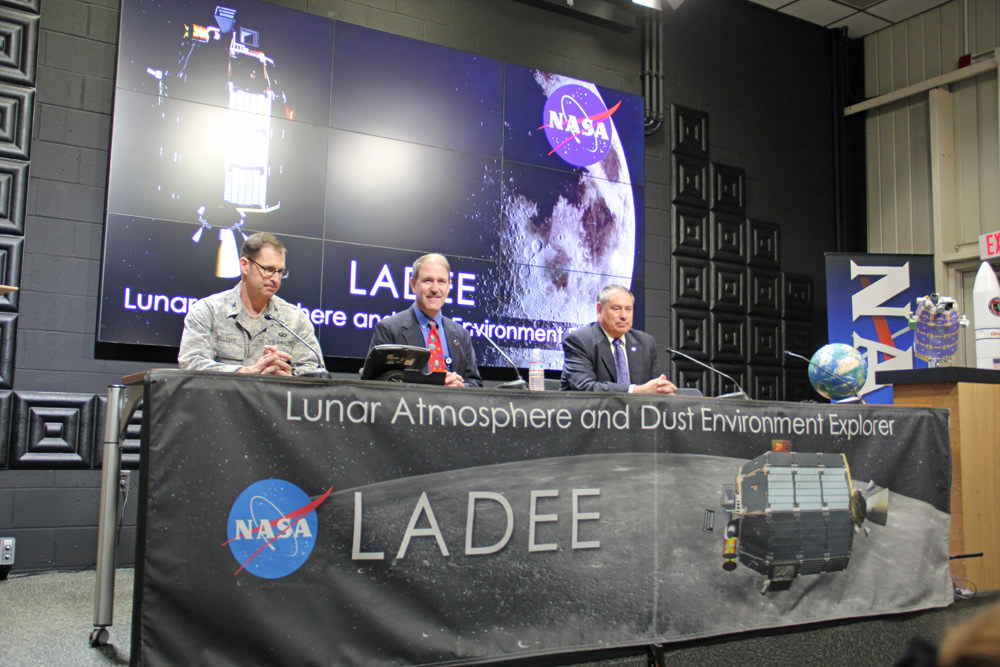

While NASA’s newest lunar probe was tracking the stars, it also captured the moon! This series of star tracker images shows Earth’s closest large neighbour from a close-up orbit. And as NASA explains, the primary purpose of these star-tracking images from the Lunar Atmosphere and Dust Environment Explorer (LADEE) was not the lunar pictures themselves.
Continue reading “Low-Flying Moon Probe Spies Craters And Mountains While Seeking Stars”
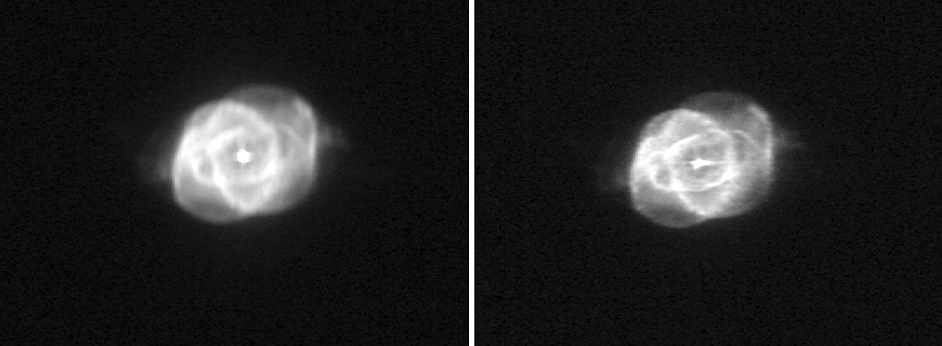
Here’s a glimpse of how a telescope gets ready for its main mission. The European Space Agency’s Gaia telescope is in the middle of a commissioning phase before mapping out the locations of stars and other objects in the Milky Way. While the nominal mission is not to take pictures, it is through these images that controllers can verify that the telescope is tuned properly to do its work.
What you’re seeing is data from the Gaia camera’s “sky-mapper strips” that are actually intensity maps rendered in black and white, ESA explained. You can see in the picture above that the shot on the left is a bit blurry, while the one on the right looks a bit sharper. That’s because controllers better calibrated the charged coupled devices to the spacecraft’s spin rate, ESA said.
Lucky for us, ESA is sharing those images so we can see the process in action. This set of pictures below follows on from a calibration image of the Large Magellanic Cloud that was released last week. More details are available at ESA and also in this Dec. 19 Universe Today story.
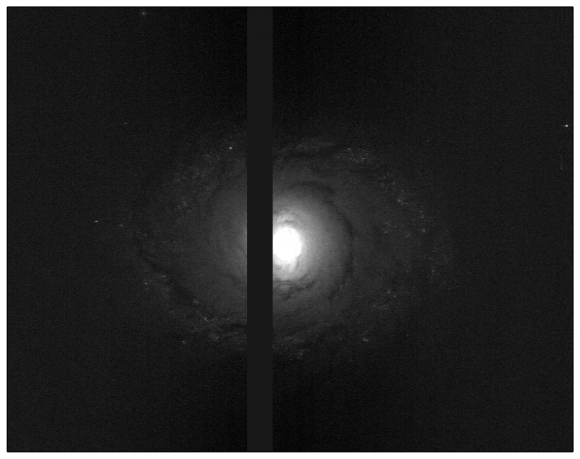
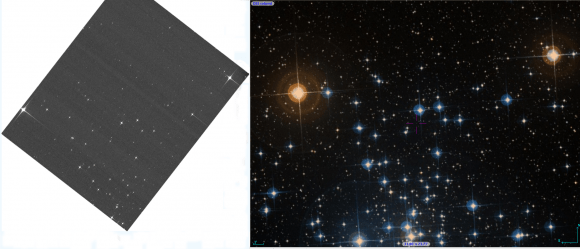
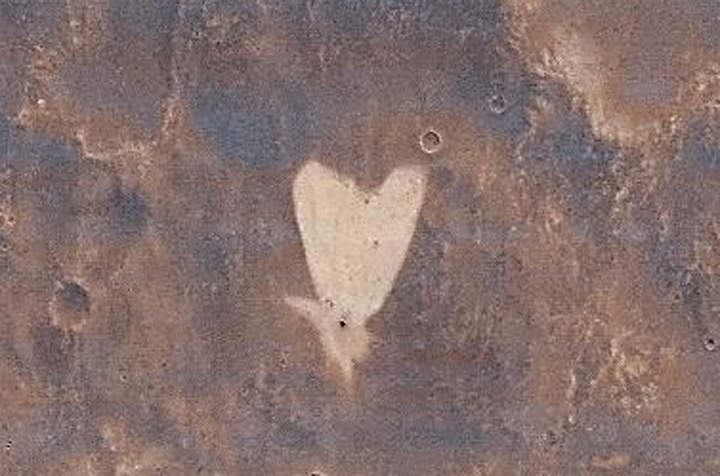
A Valentine from Earth. pic.twitter.com/7FEIIddAJB
— Karen L. Nyberg (@AstroKarenN) February 14, 2014
While we’re unsure about the status of chocolates and flowers in locations far beyond Earth, there certainly is no lack of hearts for us to look at to enjoy Valentine’s Day. If you look at enough geologic features or gas clouds, statistically some of them will take on shapes that we recognize (such as faces).
Below, we’ve collected some hearts on Mars and other places in the universe. Have we missed any? Share other astronomy hearts in the comments!
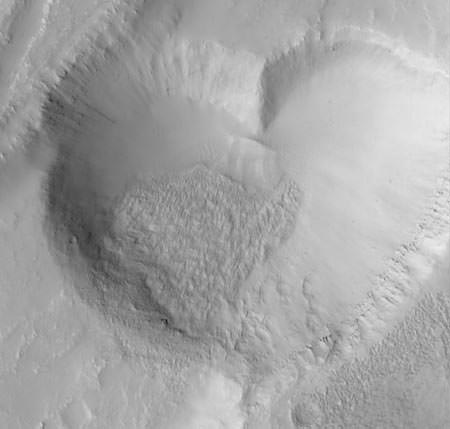

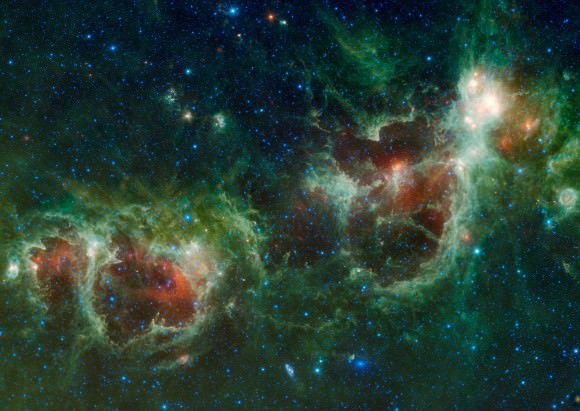
I heart you @AuroraMAX #aurora heart pic.twitter.com/DJugaWnaCW
— Angel Brise’ (@AngelBrise67) February 12, 2014
Happy Valentine’s Day, everyone! Here’s a heart @NASA_Dawn saw on Vesta. 🙂 pic.twitter.com/y7ABgrX5to
— Keri Bean (@PlanetaryKeri) February 14, 2014
Mars sends love to us all on Valentine’s Day – hearts abounding from the romantics at @NASAJPL pic.twitter.com/mD39hi7lKT
— Chris Hadfield (@Cmdr_Hadfield) February 14, 2014
Know I’ve used this before- but it seems like a good one. Happy Valentine’s Day #EarthHearts #ISSExp20 http://t.co/fc9X9zuCIr
— Nicole Stott (@Astro_Nicole) February 14, 2014
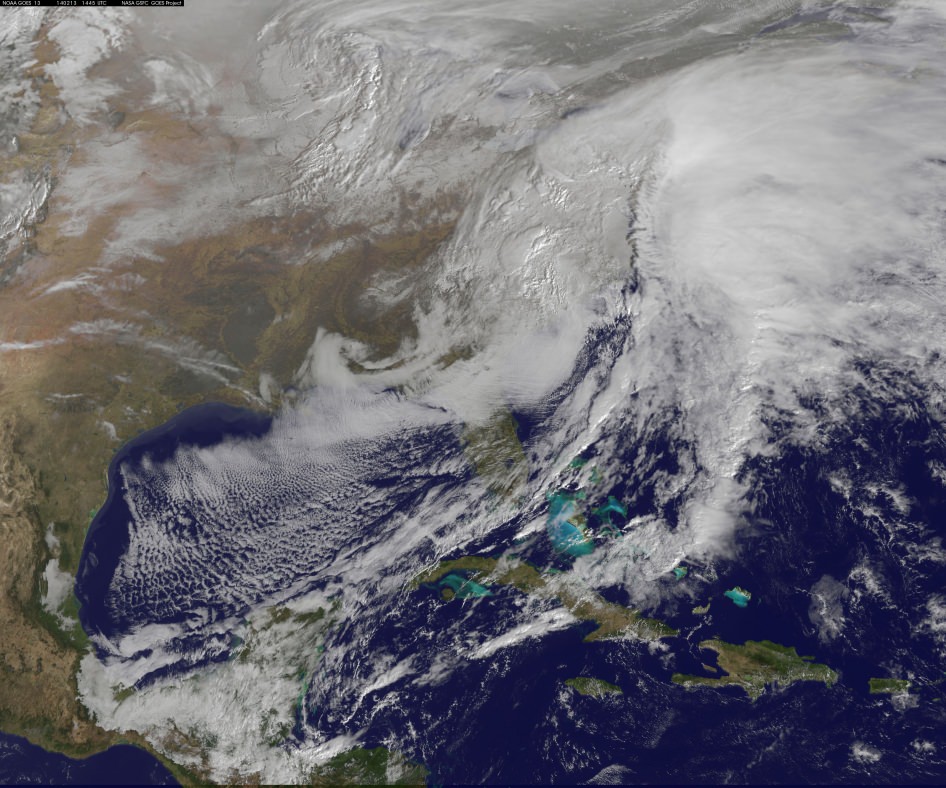
This visible image of the winter storm over the U.S. south and East Coast was taken by NOAA’s GOES-13 satellite on Feb. 13 at 1455 UTC/9:45 a.m. EST. Snow covered ground can be seen over the Great Lakes region and Ohio Valley. Image Credit: NASA/NOAA GOES Project
Story updated[/caption]
A deadly monster storm is battering virtually the entire US Eastern seaboard today, Thursday, Feb. 13, as it moves from the Southeast to the Northeast and into the New England states, wreaking havoc and causing miserable weather conditions for over 100 million Americas.
This afternoon, NASA and NOAA published a new image taken by a GOES satellite that showed the extent of the clouds associated with the massive winter storm over the US East Coast – see above and below.
Blizzard, white out and slippery conditions have already caused more than 18 deaths.
The killer storm has brought relentless waves of snow, sleet and ice over the past two days covering a vast swath stretching from inland to coastal areas as it moved up from the southern to northern states.
More than a foot of snow has already fallen in many areas today stretching from the Mid-Atlantic into the entire Northeast region.
Several states have declared states of emergency.
This is the season’s 12th snow storm. In many Northeast localities, the accumulated snowfall totals are three times the normal average. As a result many municipalities are running out of road salt.
And to add insult to injury, much more icy snow is falling overnight into Friday on top of the massive existing mounds and piles of frozen ice and snow that’s accumulated over the past few weeks of subfreezing temperatures.
There are also predictions for patches of “thunder snow” — which is a snow storm mixed with thunder and lightning!
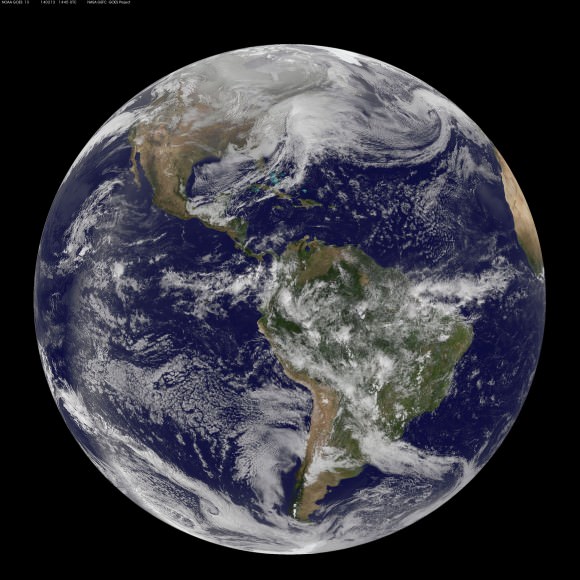
Incredibly, another round of snow is forecast for Saturday.
Much of the I-95 corridor where I also live has been especially hard hit.
The image above was created from data captured by NOAA’s GOES-East satellite today, Feb. 13 at 1455 UTC/9:45 a.m. EST by a team from the NASA/NOAA’s GOES Project at NASA’s Goddard Space Flight Center in Greenbelt, Md.
“The clouds and fallen snow data from NOAA’s GOES-East satellite were overlaid on a true-color image of land and ocean created by data from the Moderate Resolution Imaging Spectroradiometer or MODIS instrument that flies aboard NASA’s Aqua and Terra satellites,” said NASA in a statement.
An eight months pregnant 36 year old women was tragically killed in New York City accident today by a snowplow. Thank God the unborn baby was saved and delivered by cesarean section.
The storm has caused thousands of traffic accidents and several deaths.
Video Caption: This animation of NOAA’s GOES satellite data shows the progression of the major winter storm in the U.S. south from Feb. 10 at 1815 UTC/1:15 p.m. EST to Feb. 12 to 1845 UTC/1:45 p.m. EST. Credit: NASA/NOAA GOES Project, Dennis Chesters
Hundreds of thousands of customers have lost power due to fallen tree limbs on exposed power lines, mostly in the southeast. In recent days, hundreds of thousands of us here in the Northeast lost power after a severe ice storm.
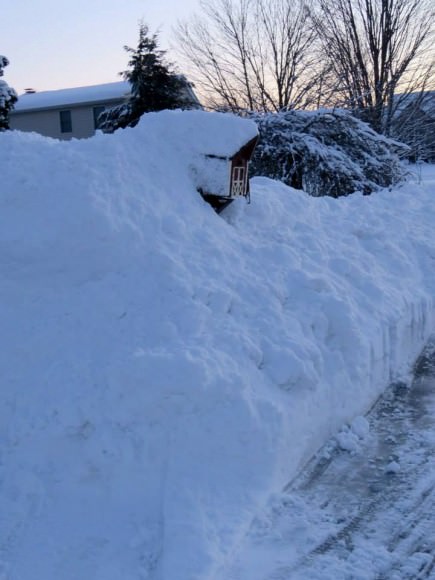
Most of those affected were left with no heat in subfreezing temperatures. It’s definitely no fun when you can see you exhaled breath – indoors.
Many school districts were closed today. But not in NYC where the new Mayor Bill DeBlasio kept schools open, and faced a hail of criticism – including from NBC News weatherman Al Roker.
Over 6500 airplane flights have been cancelled, stranding over a half million people.
So after days of shoveling, even more is on tap for the morning. Be careful, pace yourself and don’t overdo it – as several people died from heart attacks digging out the heavy slushy mess
Here is this evenings forecast (Feb 13) from the National Weather Service (NWS):
STORM SUMMARY NUMBER 09 FOR SOUTHERN PLAINS TO EAST COAST WINTER STORM
NWS WEATHER PREDICTION CENTER COLLEGE PARK MD – – 1000 PM EST THU FEB 13 2014
…LOW PRESSURE CENTER HAS MOVED OFF THE NEW JERSEY COAST AND IS
RAPIDLY INTENSIFYING…HEAVY SNOW BANDS IMPACTING INTERIOR
NORTHEAST AND I 95 CORRIDOR…WINDS INCREASING ACROSS THE AFFECTED
REGION…
WINTER STORM WARNINGS AND WINTER WEATHER ADVISORIES ARE IN EFFECT
FOR THE NORTHERN MID ATLANTIC AND NORTHEAST….
FOR A DETAILED GRAPHICAL DEPICTION OF THE LATEST
WATCHES…WARNINGS AND ADVISORIES…PLEASE SEE WWW.WEATHER.GOV
AT 900 PM EST…THE MAIN CENTER OF A RAPIDLY INTENSIFYING LOW
PRESSURE SYSTEM WITH ESTIMATED CENTRAL PRESSURE OF 986 MB…29.12
INCHES…WAS LOCATED JUST EAST OF THE SOUTHERN NEW JERSEY COAST.
NATIONAL WEATHER SERVICE DOPPLER RADAR AND SURFACE OBSERVATIONS
INDICATED THAT OVER THE PAST FEW HOURS…A BAND OF HEAVY SNOW WAS
IMPACTING CENTRAL PENNSYLVANIA ACROSS NORTHERN NEW ENGLAND TO
NORTHERN MAINE. MEANWHILE…ANOTHER BAND OF MODERATE TO HEAVY
SNOW WAS LOCATED ALONG THE I 95 CORRIDOR FROM WASHINGTON DC TO NEW YORK CITY. EAST OF I 95 THE PRECIPITATION TYPE IS MAINLY RAIN…BUT A CHANGEOVER BACK TO SNOW IS EXPECTED.
Stay tuned here for Ken’s continuing planetary and human spaceflight news.
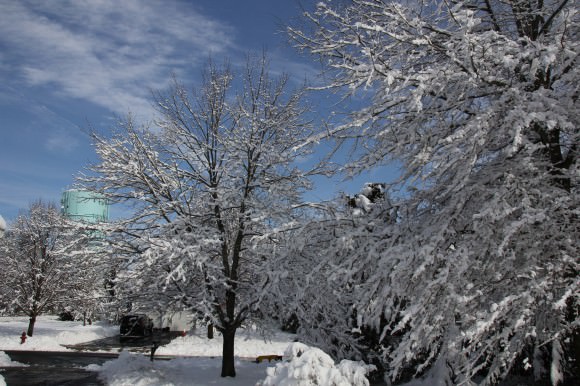


I have a new exercise routine where I watch Star Trek: The Next Generation most mornings of the week while doing my thing. Besides serving as awesome distraction, the episodes do get me thinking about how humans would talk to extraterrestrials. It likely wouldn’t be as easy as the show portrays to zoom across space to conduct diplomatic negotiations at the planet “Parliament”, for example, so interstellar communication would be a problem.
Luckily for non-engineers such as me, there are folks out there (on Earth, at least) that are examining the problem of talking between stars. David Messerschmitt, of the University of California at Berkeley, is one of those people. A new paper by him on Arxiv examines the issue. Note this is a preprint site and not a peer-reviewed journal, but all the same it provides an intriguing addition to how to communicate outside of Earth.
Messerschmitt explains that humans already communicate with probes that are a fair distance from Earth (say, Voyager 1 in interstellar space) at radio frequencies, and there is some usage now of laser/optical communications (namely between the Earth and the moon).
Across greater distances, however, you lose information, the interstellar medium gets in the way, and stars shift due to relative motion. Besides all that, at first you wouldn’t know how the other civilization designs its systems and you could therefore send a message that wouldn’t be picked up.
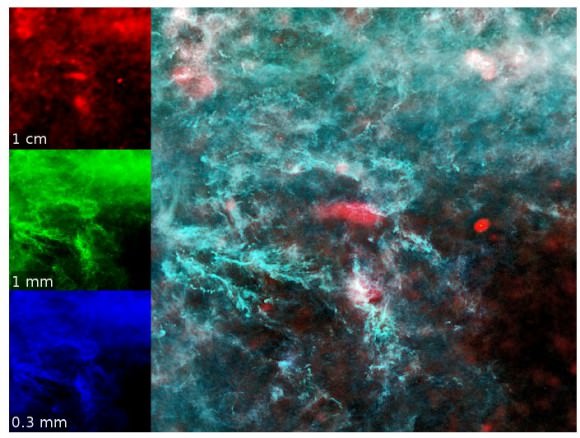
He further explains that starships and civilizations would have different communications requirements. Starship communication would be two-way and based on a similar design, so success comes by having high “uplink and downlink transmit times”. The more information, the better it would be for scientific observations and keeping down errors.
Civilization-to-civilization chats, however, would present headaches. As with all diplomatic negotiations, crafting suitable messages would take time. Then we’d have to send the message out repeatedly to make sure it is heard (which actually means that reliability is not as big of a problem.) Then the ISM would have to be contended with (something that pulsar astronomers and astrophysicists are already working on, he said).
In either case — talking to starships or other civilizations — one can assume there’d be a lot of energy involved, he added. “Starships are likely to be much closer than the nearest civilizations, but the cost of either a large transmit antenna or transmit energy is likely to be considerably greater for the starship than for a terrestrial-based transmitter,” he said, suggesting that a solution would be to minimize the energy delivered to the receiver. Other civilizations may have found more efficient ways to overcome this problem, he added.
You can read more details of the research on Arxiv, where Messerschmitt talks about Gaussian noise, channel coding and other parameters to keep in mind during communication.
There is nothing in the Universe more awe inspiring or mysterious than a black hole. Because of their massive gravity and ability to absorb even light, they defy our attempts to understand them. All their secrets hide behind the veil of the event horizon.
What do they look like? We don’t know. They absorb all the radiation they emit. How big are they? Do they have a size, or could they be infinitely dense? We just don’t know. But there are a few things we can know. Like how massive they are, and how fast they’re spinning.
Wait, what? Spinning?
Consider the massive star that came before the black hole. It was formed from a solar nebula, gaining its rotation by averaging out the momentum of all the individual particles in the cloud. As mutual gravity pulled the star together, through the conservation of angular momentum it rotated more rapidly. When a star becomes a black hole, it still has all that mass, but now compressed down into an infinitesimally smaller space. And to conserve that angular momentum, the black hole’s rate of rotation speeds up… a lot.The entire history of everything the black hole ever consumed, averaged down to a single number: the spin rate.
If the black hole could shrink down to an infinitely small size, you would think that the spin rate might increase to infinity too. But black holes have a speed limit.
“There is a speed limit to the spin of a black hole. It’s sort of set by the faster a black hole spins, the smaller is its event horizon.”
That’s Dr. Mark Morris, a professor of astronomy at UCLA. He has devoted much of his time to researching the mysteries of black holes.
“There is this region, called the ergosphere between the event horizon and another boundary, outside. The ergosphere is a very interesting region outside the event horizon in which a variety of interesting effects can occur.”

Imagine the event horizon of a black hole as a sphere in space, and then surrounding this black hole is the ergosphere. The faster the black hole spins, the more this ergosphere flattens out.
“The speed limit is set by the event horizon, eventually, at a high enough spin, reaches the singularity. You can’t have what’s called a naked singularity. You can’t have a singularity exposed to the rest of the Universe. That would mean that the singularity itself could emit energy or light and somebody outside could actually see it. And that can’t happen. That’s the physical limitation of how fast it can spin. Physicists use units for angular momentum that are cast in terms of mass, which is a curious thing, and the speed limit can be described as the angular momentum equals the mass of the black hole, and that sets the speed limit.”
Just imagine. The black hole spins up to the point that it’s just about to reveal itself. But that’s impossible. The laws of physics won’t let it spin any faster. And here’s the amazing part. Astronomers have actually detected supermassive black holes spinning at the limits predicted by these theories.
One black hole, at the heart of galaxy NGC 1365 is turning at 84% the speed of light. It has reached the cosmic speed limit, and can’t spin any faster without revealing its singularity.
The Universe is a crazy place.
Just a few days ago, we posted about possibly salty water flows on Mars. Of note, the NASA press release noted, moisture is likely more prevalent in the morning and the Mars Reconnaissance Orbiter does most observations in the afternoon, local time. That’s too bad, we thought. But wait! It turns out that NASA Mars Odyssey spacecraft is going to change its orbit to get a better look.
It’s going to take nearly two years for NASA to maneuver the long-running Odyssey to the right spot, but at that point mission managers expect the spacecraft still has another decade of observations ahead of it based on current fuel consumption. That’s great considering that the spacecraft has been beaming back images since 2001!
Odyssey will be the first spacecraft to do dedicated morning observations of the planet since any NASA orbiter of the 1970s, which dates observations back to the Viking era (except for a few glimpses by European Space Agency spacecraft and previous NASA orbiters). Advances in imaging mean we will get a far clearer view of the ground than ever before.
“The change will enable observation of changing ground temperatures after sunrise and after sunset in thousands of places on Mars,” NASA stated. “Those observations could yield insight about the composition of the ground and about temperature-driven processes, such as warm-season flows observed on some slopes, and geysers fed by spring thawing of carbon-dioxide ice near Mars’ poles.”
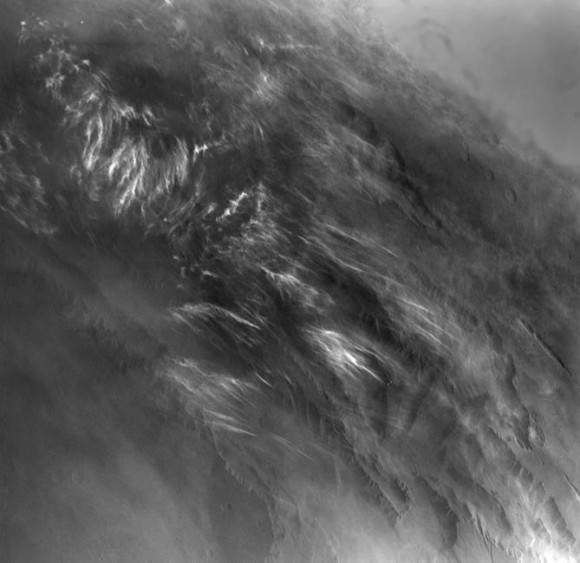
The first maneuver took place Tuesday (Feb. 11) when a brief firing of Odyssey’s engines got the spacecraft pushing faster for an orbital shift. It will drift in that direction until November 2015, when controllers will do another maneuver to keep it in a stable location.
Right now, Odyssey is in a near-polar orbit that keeps local daylight at the same time below it. There have been a few changes to the timing over its dozen years of operation:
“We don’t know exactly what we’re going to find when we get to an orbit where we see the morning just after sunrise,” stated Philip Christensen of Arizona State University, who is THEMIS principal investigator and the person who suggested the move. “We can look for seasonal differences. Are fogs more common in winter or spring? We will look systematically. We will observe clouds in visible light and check the temperature of the ground in infrared.”
“We know that in places, carbon dioxide frost forms overnight,” he added. “And then it sublimates immediately after sunrise. What would this process look like in action? How would it behave? We’ve never observed this kind of phenomenon directly.”
Sources: NASA Jet Propulsion Laboratory and Arizona State University
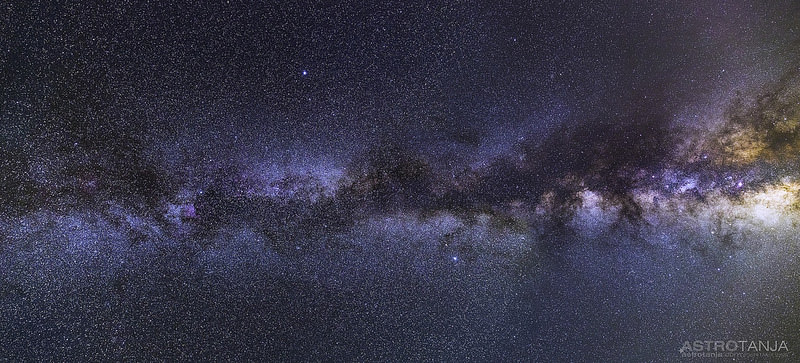
This gorgeous view of the Milky Way was taken by astrophotographer Tanja Sund during a trip to the desert in Nevada. Made from just two images, this long exposure (180 seconds) mosaic has incredible detail and stunning clarity. You seriously need to click on this image to see a larger version!
See more of Tanja’s work at her Flickr page. She has some beautiful night sky and aurora photos, as well as some striking landscape imagery.
Want to get your astrophoto featured on Universe Today? Join our Flickr group or send us your images by email (this means you’re giving us permission to post them). Please explain what’s in the picture, when you took it, the equipment you used, etc.
The issue of “what to wear?” takes on an extra dimension of life and death when it comes to space travel. Upon exiting a spacecraft on a spacewalk, an astronaut becomes his very own personal satellite in orbit about the Earth and must rely on the flimsy layer of his suit to provide them with a small degree of protection from radiation and extreme fluctuations of heat and cold.
We recently had a chance to see the past, present and future of space suit technology in the Smithsonian Institutions’ touring Suited for Space exhibit currently on display at the Tampa Bay History Center in Tampa, Florida.
Tampa Bay History Center Director of Marketing Manny Leto recently gave Universe Today an exclusive look at the traveling display. If you think you know space suits, Suited for Space will show you otherwise, as well as give you a unique perspective on a familiar but often overlooked and essential piece of space hardware. And heck, it’s just plain fascinating to see the design and development of some of these earlier suits as well as videos and stills of astronauts at work – and yes, sometimes even at play – in them.
One of the highlights of the exhibit are some unique x-ray images of iconic suits from space travel history. Familiar suits become new again in these images by Smithsonian photographer Mark Avino, which includes a penetrating view of Neil Armstrong’s space suit that he wore on Apollo 11.
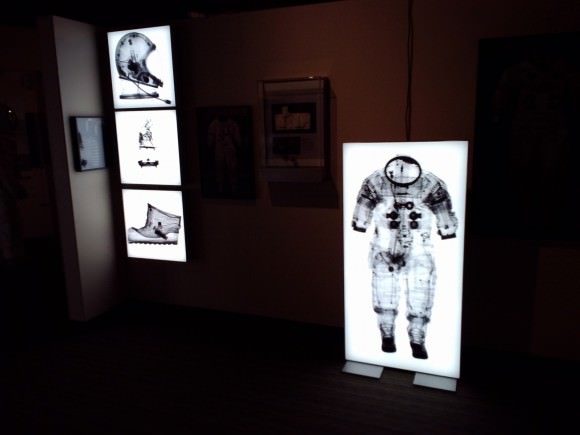
Space suits evolved from pressure suits developed for high-altitude flights in the 1950’s, and Suited for Space traces that progression. It was particularly interesting to see the depiction of Wiley Post’s 1934 suit, complete with steel cylindrical helmet and glass portal! Such early suits resembled diving bell suits of yore — think Captain Nemo in a chemsuit. Still, this antiquated contraption was the first practical full pressure suit that functioned successfully at over 13,000 metres altitude.
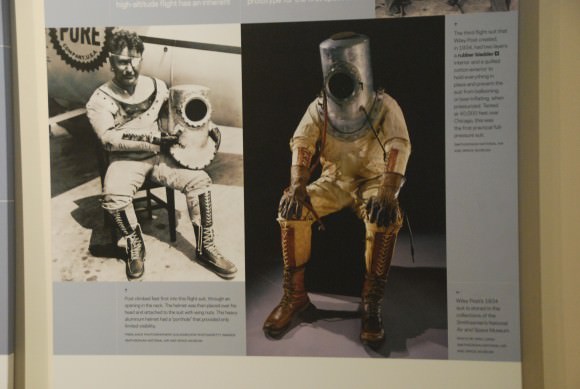
No suit that has been into space is allowed to tour due to the fragility of many historic originals that are now kept at the Smithsonian, though several authentic suits used in training during the U.S. space program are on display. We thought it was interesting to note how the evolution of the spacesuit closely followed the development of composites and materials through the mid-20th century. You can see the progression from canvas, glass and steel in the early suits right up though the advent of the age of plastic and modern fabrics. Designs have flirted with the idea of rigid and semi-rigid suits before settling on the modern day familiar white astronaut suit.
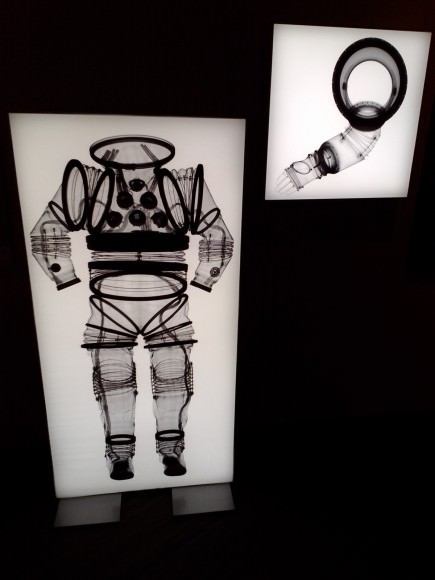
Spacesuit technology has also always faced the ultimate challenge of protecting an astronaut from the rigors of space during Extra-Vehicular Activity, or EVA.
Cosmonaut Alexey Leonov performed the first 12 minute space walk during Voskhod 2 back in 1965, and NASA astronaut Ed White became the first American to walk in space on Gemini 4 just months later. Both space walkers had issues with over-heating, and White nearly didn’t make it back into his Gemini capsule.
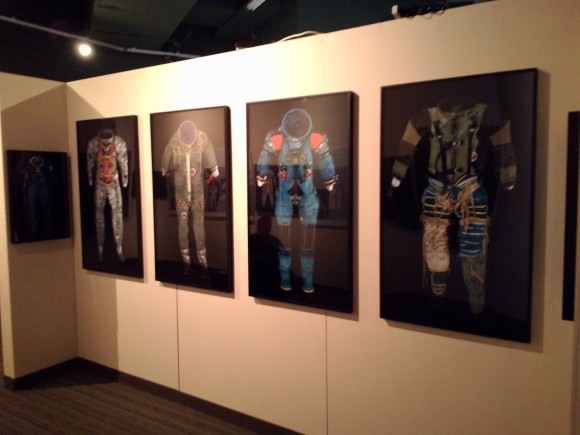
Designing a proper spacesuit was a major challenge that had to be overcome. In 1962, Playtex (yes THAT Playtex) was awarded a contract to develop the suits that astronauts would wear on the Moon. Said suits had 13 distinct layers and weighed 35 kilograms here on Earth. The Playtex industrial division eventually became known as the International Latex Corporation or ILC Dover, which still makes spacesuits for ISS crewmembers today. It’s also fascinating to see some of the alternate suits proposed, including one “bubble suit” with arms and legs (!) that was actually tested but, thankfully, was never used.
These suits were used by astronauts on the Moon, to repair Hubble, build the International Space Station and much more. Al Worden recounts performing the “most distant EVA ever” on the return from the Moon in his book Falling to Earth. This record will still stand until the proposed asteroid retrieval mission in the coming decade, which will see astronauts performing the first EVA ever in orbit around Earth’s Moon.
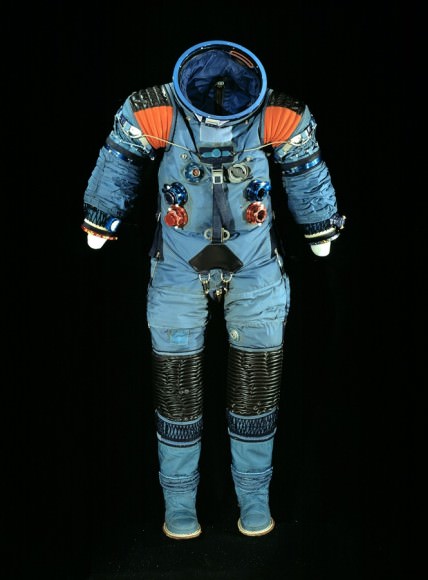
And working in a modern spacesuit during an EVA is anything but routine. CSA Astronaut Chris Hadfield said in his recent book An Astronaut’s Guide to Life on Earth that “Spacewalking is like rock climbing, weightlifting, repairing a small engine and performing an intricate pas de deux – simultaneously, while encased in a bulky suit that’s scraping your knuckle, fingertips and collarbone raw.”
And one only has to look at the recent drama that cut ESA astronaut Luca Parmitamo’s EVA short last year to realize that your spacesuit is the only thin barrier that exists between yourself and the perils of space.
“We’re delighted to host our first Smithsonian Institution Travelling Exhibition Service (SITES) and we think that Florida’s close ties to NASA and the space program make it a great fit for us,” said Rodney Kite-Powell, the Tampa Bay History Center’s Saunders Foundation Curator of History.
Be sure to catch this fascinating exhibit coming to a city near you!
-And you can see these suits in action on the up and coming future EVAs for 2014.
-Here’s the schedule for Suited for Space Exhibit tour.
-Astronaut Nicole Stott (veteran of STS-128, -129, -133, & ISS Expeditions 20 and 21) will also be on hand at the Tampa Bay History Center on March 2014 (Date to be Announced) to present Suited for Space: An Astronaut’s View.
– Follow the Tampa Bay History Museum of Twitter as @TampaBayHistory.